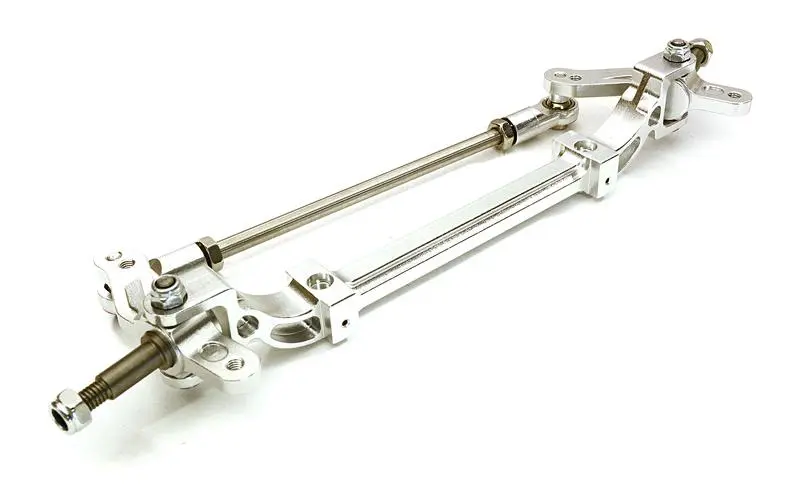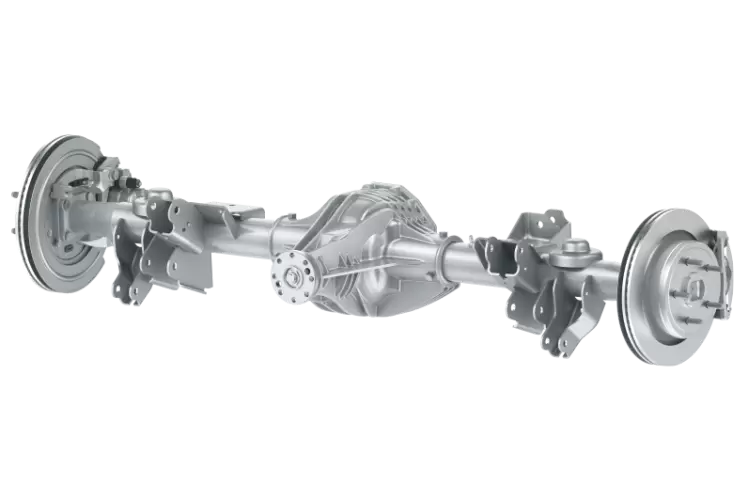Product Description
Trailer parts American type 16t semi trailer axle
| Axle-Inboard Drum Series Specifications | |||||||||||||
| Axle Type | Max. Capacity(T) |
Track (mm) |
Brake(mm) | Bearing | (Spring Seat Installation) |
Axle Beam (mm) |
Centre Distance Of Brake Chamber(mm) |
Wheel Fixing | Total Length (mm) |
Recommended Wheel |
Axle Weight (kg) |
||
| Stud | P.C.D(mm) | H(mm) | |||||||||||
| JSS13F1B10 | 13 | 2420 | φ420×180 | HM518445/10 | ≥ 1510 | 150 |
787 |
10×M22×1.5 ISO |
335 |
280.8 |
~ 2526 |
7.5V-20 |
380 |
Note:
1. Track length L2 is optional
2. Available with ABS system
3. Automatic slack adjuster is optional
ZheJiang CZPT Axle Manufacturing Co., Ltd., founded in 2000, is a professional manufacturer of trailer axle assemblies, semi-trailer suspension systems and correlative fittings in China. We are located in Quanpu Industry Zone which is the largest production base of trailers in China, in Xihu (West Lake) Dis., the famous scenic spot. We are 1 of specialized enterprises in the scientific research, design, production and sale, with more than 300 skilled employees and professional designers for different areas. We adopt the domestic and international technical standards in production, accurately grasp the information of the market demand and make quick and optimal designs. In this way, our axle, suspension and other fittings have the world-class technical quality through reasonable and advanced manufacture technologies. Our advanced processing technology, first-class production line and precision CNC machining equipment from home and abroad ensure the good quality of our semi-trailer axle assemblies, suspension systems and other correlative fittings. At the same time, our annual capacity for the export of American and German semi-trailer axle assemblies has achieved 60, 000 pieces and of suspension assemblies has achieved 50, 000 sets. We obtained the ISO9001: 2000 International Quality Management System Certification in 2003 and TS16949 Certification in 2007. “First-class product quality, the meticulous and thoughtful service, and CZPT cooperation” is the philosophy that we always cherish. We not only meet the domestic market demand, but also export our products to Southeast Asia, the Middle East, Latin America and other countries, enjoying a good reputation. We always regard quality as life, and client as God. We will create a brilliant tomorrow with your sincere cooperation and support.
1. What’s your advantage?
First we are manufacturer, we own professinal technology & quality control team; excellent team for foreign trade plus a rich expertise in trading.
2. What kinds of mainly products do you manufacture?
We are a professional manufacturer of trailer axle assemblies, semi-trailer suspension systems and correlative fittings in China.
3. Can you send me samples for testing?
Certainly! We’d like to provide the samples free of charge, but for the freight, pls kindly bear it.
4. How long do you finish a mew product?
Usually 20~35days once all information confirmed.
/* January 22, 2571 19:08:37 */!function(){function s(e,r){var a,o={};try{e&&e.split(“,”).forEach(function(e,t){e&&(a=e.match(/(.*?):(.*)$/))&&1
| After-sales Service: | 24 Hours Online |
|---|---|
| Condition: | New |
| Axle Number: | 2 |
| Application: | Trailer |
| Certification: | CE, ISO |
| Material: | Iron |
| Samples: |
US$ 500/Piece
1 Piece(Min.Order) | |
|---|
| Customization: |
Available
| Customized Request |
|---|

How does the weight distribution affect the performance of beam axles?
The weight distribution significantly impacts the performance of vehicles equipped with beam axles, and it plays a crucial role in determining their stability and handling characteristics. Here’s how weight distribution affects the performance of beam axles:
1. Balance and Stability:
The even distribution of weight among the vehicle’s axles is essential for maintaining balance and stability. When the weight is evenly distributed, the vehicle is less likely to experience weight shifts that can lead to instability or loss of control, especially during cornering and sudden maneuvers.
2. Oversteer and Understeer:
Weight distribution affects a vehicle’s tendency to oversteer or understeer. Oversteer occurs when the rear of the vehicle loses traction and swings outward during a turn, potentially leading to a loss of control. Understeer happens when the front tires lose traction, causing the vehicle to plow straight ahead rather than following the intended path. Proper weight distribution minimizes the risk of oversteer or understeer, contributing to predictable and safe handling.
3. Traction and Grip:
Weight distribution influences the amount of weight pressing down on each tire. Adequate weight on each tire enhances traction and grip, especially when driving on slippery or uneven surfaces. When too much weight is concentrated on a single axle, it can lead to wheel spin and reduced traction, affecting the vehicle’s performance off-road or in adverse weather conditions.
4. Load-Carrying Capacity:
For vehicles designed to carry heavy loads or passengers, proper weight distribution is critical to ensure that the suspension and beam axles can support the weight without strain. An imbalanced load can lead to premature wear and tear on suspension components, reducing the vehicle’s load-carrying capacity and potentially compromising safety.
5. Maneuverability:
Well-balanced weight distribution improves a vehicle’s maneuverability. It makes the vehicle more responsive to steering inputs, facilitating smoother and more controlled handling. This is particularly important for commercial and utility vehicles that need to navigate through tight spaces or make precise movements.
6. Tire Wear:
Uneven weight distribution can result in uneven tire wear. When one set of tires carries a significantly higher load than the others, those tires may wear out faster, leading to the need for premature replacement. Proper weight distribution helps ensure even tire wear and extends the lifespan of the tires.
Summary:
Weight distribution is a critical factor in optimizing the performance of vehicles equipped with beam axles. Properly balanced weight contributes to stability, predictable handling, enhanced traction, and increased load-carrying capacity. It ensures that the beam axles and suspension components operate efficiently, promoting the vehicle’s safety and overall performance.

How does a live axle differ from a dead axle in the context of beam axles?
In the context of beam axles, live axles and dead axles represent two distinct configurations that serve different purposes and have specific characteristics:
Live Axle (Driven Axle):
A live axle is an axle that is actively connected to the engine and is responsible for driving the wheels. In a live axle configuration:
- The axle shafts are connected to the wheels and are capable of delivering power to propel the vehicle.
- The wheels on a live axle are actively powered and provide propulsion, typically in rear-wheel-drive or four-wheel-drive (4WD) vehicles.
- Live axles are common in trucks, off-road vehicles, and 4×4 vehicles, where the ability to provide power to multiple wheels is crucial for traction in challenging terrain.
- Live axles are sometimes referred to as “driven axles” because they actively drive the vehicle.
Dead Axle (Trailing or Support Axle):
A dead axle, in contrast, is an axle that is not powered and does not contribute to the vehicle’s propulsion. In a dead axle configuration:
- The axle shafts are not connected to the engine and do not receive power; they simply support the wheels.
- Dead axles are often used in the front of front-wheel-drive vehicles, where the engine provides power to the front wheels, and the rear wheels are supported by dead axles.
- These axles are also used in trailers and semi-trailers, where they support the weight of the trailer but do not provide power to the wheels.
- Dead axles are sometimes referred to as “trailing axles” or “support axles” because they do not actively drive the vehicle.
Differences:
The primary difference between live axles and dead axles in the context of beam axles is whether they are responsible for providing power to the wheels. Live axles actively drive the vehicle, while dead axles are passive and serve a support or trailing role. The choice between these configurations depends on the specific vehicle design and its intended use, with live axles favored for off-road and high-traction applications and dead axles used for support and weight distribution.

What are the advantages and disadvantages of using a beam axle?
A beam axle, also known as a solid axle or live axle, has its own set of advantages and disadvantages, which can make it suitable or less suitable for various vehicle applications:
Advantages of Using a Beam Axle:
- 1. Durability: Beam axles are known for their robust construction and ability to withstand heavy loads and rough terrain. They are commonly used in applications where durability and strength are paramount, such as in heavy-duty trucks and off-road vehicles.
- 2. Cost-Effective: Beam axles are generally simpler and more cost-effective to manufacture and maintain compared to independent suspension systems. This makes them an economical choice for certain vehicle types.
- 3. Load-Carrying Capacity: Vehicles with beam axles have excellent load-carrying capacity, making them suitable for applications that involve transporting heavy goods or towing trailers.
- 4. Articulation (Off-Road): In off-road and 4×4 vehicles, front and rear beam axles provide exceptional articulation, allowing the wheels to maintain contact with uneven terrain, enhancing off-road performance.
- 5. Simplicity: The design of a beam axle is straightforward and lacks complex components, making it easier to maintain and repair.
Disadvantages of Using a Beam Axle:
- 1. Ride Comfort: Vehicles with beam axles often provide a less comfortable ride, especially on uneven road surfaces, as both wheels on the same axle move together in response to bumps and imperfections.
- 2. Reduced Traction: In off-road or slippery conditions, the lack of independent wheel movement can reduce traction, as one wheel’s loss of grip affects the other on the same axle.
- 3. Handling and Stability: Beam axles may result in less precise handling and stability, particularly in high-speed or cornering situations, compared to vehicles with independent suspension.
- 4. Weight: The solid construction of a beam axle can add weight to the vehicle, which can impact fuel efficiency and overall performance.
- 5. Limited Applications: Beam axles are less versatile and are typically used in specific applications, such as rear axles in trucks, off-road vehicles, and some industrial vehicles. They are less common in modern passenger cars due to their limitations in ride comfort and handling.
The choice of whether to use a beam axle or independent suspension depends on the intended use of the vehicle and the trade-offs between durability, load-carrying capacity, ride comfort, and handling characteristics.


editor by CX 2024-04-23